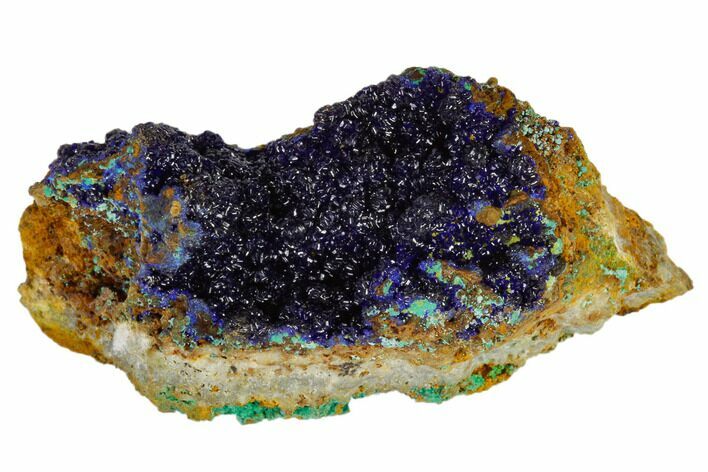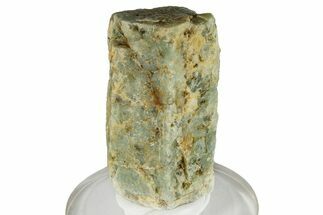This Specimen has been sold.
1.9" Azurite and Malachite Association - Hidden Treasure Mine, Utah
This colorful specimen contains deep blue azurite that is associated with green malachite formations. It was collected from the Hidden Treasure Mine in the Ophir District of Utah, a location that's well known for its zinc and copper mineral deposits.
About Malachite
Malachite is an intense green copper-based mineral that can be found in a wide variety of forms. Malachite can grow in botryoidal masses, stalactitic formations, and reniform formations, typically as a tight cluster of fanning fibrous needles that make up a seemingly solid mass. As layers continue to stack during formation, banded patterns can sometimes begin to take shape, explaining the rings in all shades of green seen on most polished malachite specimens.
Malachite results from the weathering of other copper ores, and is very often found associated with other copper-based minerals such as azurite and chrysocolla. It can be found in copper deposits around the world, but the Democratic Republic of the Congo is the primary source for polished malachite and mineral specimens.
Malachite has been prized since ancient times, first as a utilitarian copper ore, then as an ornamental stone. Due to its value as a decorative stone, it is rarely mined as a copper ore anymore.
Malachite is an intense green copper-based mineral that can be found in a wide variety of forms. Malachite can grow in botryoidal masses, stalactitic formations, and reniform formations, typically as a tight cluster of fanning fibrous needles that make up a seemingly solid mass. As layers continue to stack during formation, banded patterns can sometimes begin to take shape, explaining the rings in all shades of green seen on most polished malachite specimens.
Malachite results from the weathering of other copper ores, and is very often found associated with other copper-based minerals such as azurite and chrysocolla. It can be found in copper deposits around the world, but the Democratic Republic of the Congo is the primary source for polished malachite and mineral specimens.
Malachite has been prized since ancient times, first as a utilitarian copper ore, then as an ornamental stone. Due to its value as a decorative stone, it is rarely mined as a copper ore anymore.
About Azurite
Azurite is a copper carbonate hydroxide mineral best known for its beautiful and vibrant blue appearance. Azurite typically forms in nodular formations with other colorful, copper-rich minerals. It is a secondary mineral that precipitated in pores, crevices, and caverns from water with high concentrations of carbon dioxide.
Azurite and malachite are known to form in union with each other since their chemical makeup is very similar. In fact, the presence of more or less water in the location of formation is enough to determine whether an abundance of malachite over azurite, or vise-versa, will accumulate.
Azurite is a copper carbonate hydroxide mineral best known for its beautiful and vibrant blue appearance. Azurite typically forms in nodular formations with other colorful, copper-rich minerals. It is a secondary mineral that precipitated in pores, crevices, and caverns from water with high concentrations of carbon dioxide.
Azurite and malachite are known to form in union with each other since their chemical makeup is very similar. In fact, the presence of more or less water in the location of formation is enough to determine whether an abundance of malachite over azurite, or vise-versa, will accumulate.
SPECIES
Malachite & Azurite
LOCATION
Hidden Treasure Mine, Ophir District, Utah
SIZE
1.9 x .8"
CATEGORY
ITEM
#119505
 Reviews
Reviews













